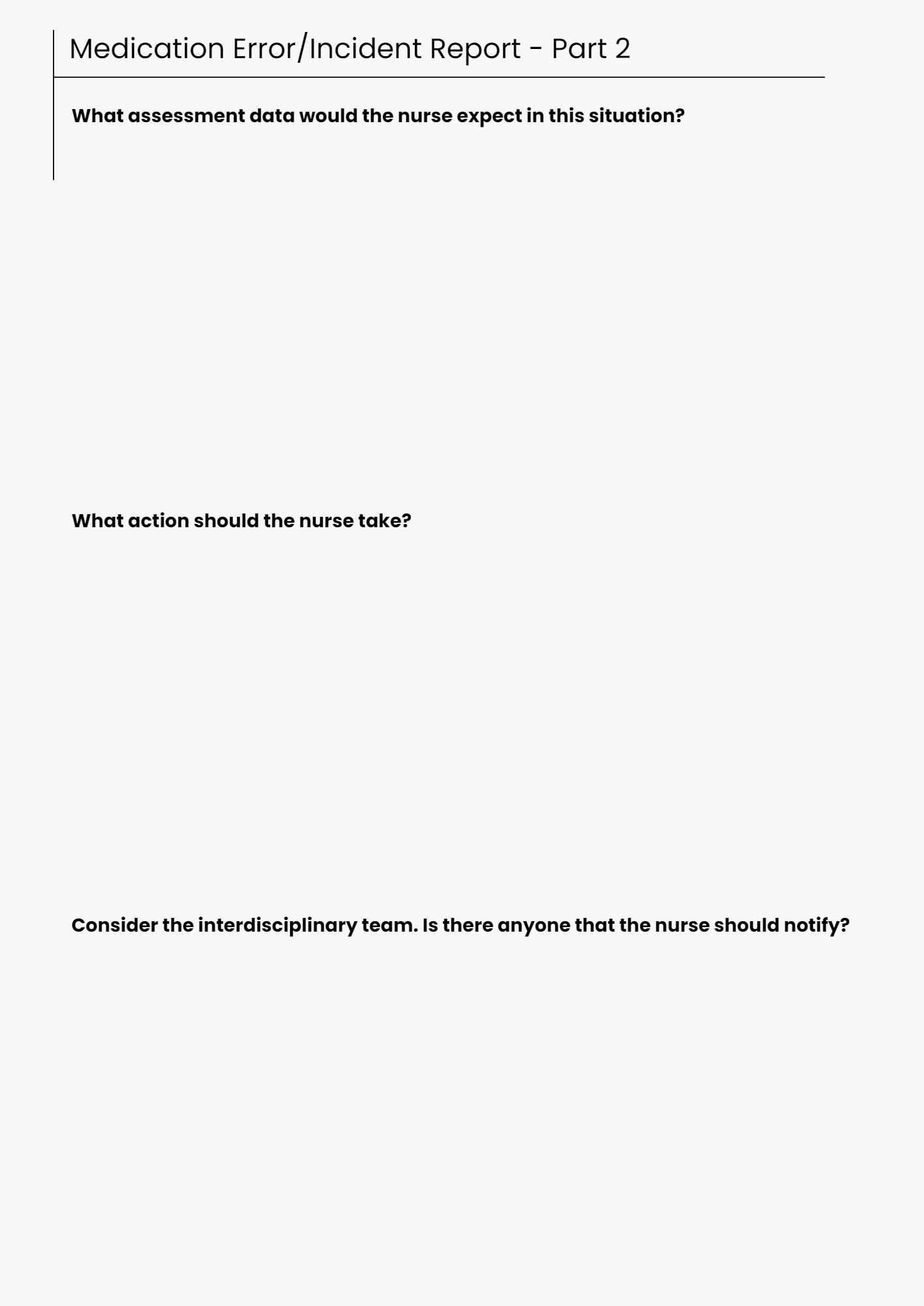An Incident Report Activity that Helps Students Learn about Failure
Have you heard of the "Impossible Project?" 🕵🏽♀️
It is a concept proposed by Paul Feigenbaum where students start a project that they cannot possibly complete in the given time frame. The project leads to "communal failure," where everyone fails a task together. The idea is that it exposes students to failure and opens up discussion about how to learn from unsuccessful attempts, including how it is okay to fail.
Failure as a Learning Tool
Is it safe to fail?
There is a cultural narrative around failure, especially in nursing school and higher education. Failure is a significant source of fear and anxiety for students at all levels. As Feigenbaum explains, "a failing grade on a paper or exam seems like a profound judgment on one's talent and ability rather than a temporary and contingent evaluation from which one might obtain valuable feedback on improving one's future performance." As a result, grades can become inherently tied to self-worth, character, and how students view their potential as a nurse.
Tools for Educators
And while there are some options, such as low-stakes grading, to help alleviate some of these feelings, it will be tough for nursing educators to change this overwhelming cultural narrative.
This post aims to give educators a tool to use to help students learn from and manage failure. First, we must accept that failure is guaranteed and inevitable when students learn. But by emphasizing learning from mistakes, we can help shift the perception of failure and give students practice managing the event before it inevitably happens.
How to Implement an Incident Report Activity
I have made errors as a nurse. I remember every incident in great detail. Part of what makes it so memorable is that I had to relive the moment immediately when I wrote an incident report.
An incident report can be an excellent tool for teaching. I've created a worksheet you can download and included a few ideas for using this worksheet with students.
In this activity, students create a fictional medication error. By asking them to write an incident report, it is a kind of forced mistake where they can see and imagine how a failure would look and feel. But by exposing them to an error in a safe environment, we can reform it into something instructive, good, and constructive. This activity forces students to accept a failure that happened, anticipate patient needs once it happens, and reflect on the emotions that will inevitably come with a medication mistake.
Part 1
Part 1 has students create a fictional error or incident.
Download the full worksheet below.
In-Person Classroom
💊 Medication errors are often the cause of incident reports in nursing. For this reason, pharmacology content lends itself well to incident reports. But you could also use this idea for patient safety, such as falls or in a leadership course related to staffing issues or equipment failure.
1️⃣ Start by having groups complete Part 1 of the worksheet. Ask them to use their imaginations to create different medication error scenarios. Include medications from your current theory course or do a broad pharmacology review. Consider making errors in dosage, route, time, medication, or person; students can potentially use all or only one of the five patient rights.
🛑Have the first group stop at question #7. They will need to mark "YES" here and ensure that the error reaches the patient so that the next group can complete part 2.
2️⃣ Once complete, rotate the sheets between groups. Instruct the new group read the scenario. Once they understand the error, they will complete sections 8 and 9 as well as the second page of the worksheet.
Part 2
Part 2 asks students to imagine the clinical scenario when the error reaches the patient.
Part 2 asks students to imagine the clinical scenario when the error reaches the patient. What assessment data would they anticipate? For example, suppose the first group indicated that the patient received 10x the ordered morphine. In that case, the nurse should anticipate decreased respiratory rate, decreased level of consciousness, low oxygen saturation, etc.
Next, students must decide what the nurse should do. Is there an antidote available? What additional monitoring is needed? Is it lab values, diagnostics, or treatments such as dialysis?
In the final section of Part 2, students must decide who else should be involved. At the minimum, they should note that the nurse must notify the provider. But other support, such as respiratory therapy, a rapid-response nurse, or poison control, may also be options depending on the scenario.
Once Part 2 is complete, you can keep the worksheet with the same group or rotate the sheets again.
3️⃣ Part 3 asks students to reflect on the medication error. At this point, I tell students about the first time I made a medication error. I emphasize the absolute horror I felt when I found that the incident report asked for the date/time I notified the provider. I had not anticipated having to make that call, and it made the situation extremely intense for me. This section instructs students to reflect on their feelings and how they would prepare to call the provider or notify a family.
Part 3
Part 3 dives deeper into the reflection on the error.
Finally, it asks for an idea for a system that could prevent the error. This question is one of my favorite parts of this activity. Students with previous work experience in healthcare may have fantastic, innovative ideas they have seen elsewhere. Some may have worked in industries with safety standards that would translate to nursing. Others may have no ideas, so I would instruct them to head to a library resource and see what they can find.
**If you are looking for additional pharmacology-related content, check out the other active learning classroom activity - Would you Give this Med? - HERE.
Using an Incident Report in Clinical
This worksheet can also be helpful at clinical. Here are a few options:
💊 Medication Check-off - I tell my clinical students if they come to me to check off their medications and have an error, it is just like having the error reach the patient. For example, I consider it an error if they should have pulled two tablets from the Pyxis and only have one. It is an optimal time to stress the importance of doing medication checks independently. Even though the error does not reach the patient, I have them complete this mock incident report.
The most valuable part is when they reflect on the potential cause of the error. It is a humbling reflection when students have to write out what steps they skipped or simple safety systems they bypassed.
🩺There is incredible value in sharing your own experience as a nurse. Post-conference is an excellent time to share a story from your practice using this incident report form. Here is how I use the form through a story:
“As a new nurse, I bypassed the barcode scanning system and scanned my meds after administration to save time. Unfortunately, I discovered my error when I did scan the barcode. When recounting the events, I include as many details as possible about the patient, the medications, the g-tube I used to administer the medications through, and the follow-up monitoring I completed.”
Then I ask students to complete the incident report as if they were the nurse who made the error. You can use a true or fictional story, but these narratives are powerful teachers.
Virtual Option
This worksheet is easy to adapt to an online discussion post. As the instructor, you could complete Part 1 so that everyone has the same scenario to work from and have students submit the remaining parts as an assignment.
It would also work nicely as a discussion board assignment. For example, students could post an error they created, and responding students could answer one or two of the reflection questions.
Who is this activity best for?
Completing a mock incident report is an active learning activity for any level of nursing student. It requires higher levels of thinking, including creating when students write out the error that occurred. Pharmacology is often woven throughout all curriculum levels, so this activity could be used throughout a program. Even beginning students learning about safety could benefit from imagining a scenario of a patient fall or a needle stick.
Incident Report as an Active Learning Tool
Completing an incident report as a nurse is a humbling experience. It forces deep reflection on your practice, your adherence to safety protocols, and what shortcuts you have made acceptable in your work. Offering this experience to students in a safe environment can initiate this reflection before any harm reaches the patient. It is a forced failure, and these can be valuable learning experiences.
Looking for more active learning ideas?
There are many more helpful, practical articles in the Idea Bank.
Or, if you would like to incorporate active learning into your classroom, check out BreakoutRN products.
References
Feigenbaum, P. (2021). Telling students it’s O.K. to fail, but showing them it isn’t: Dissonant paradigms of failure in higher education. Teaching & Learning Inquiry, 9(1), 13–27.



